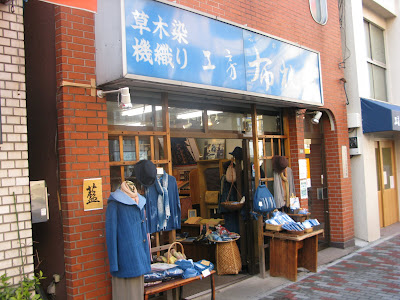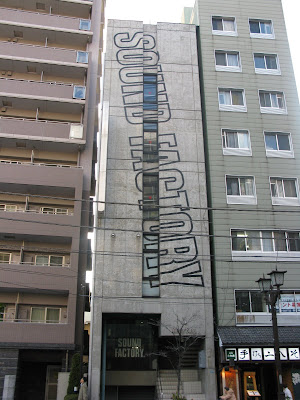
 Komagome is the next stop along from Sugamo, and this was my first Yamanote Line stop of the New Year on a day that had almost spring-like weather. There are two exits to the station, and headed to the North/South exit, which looked more promising as far as things to see were concerned.
Komagome is the next stop along from Sugamo, and this was my first Yamanote Line stop of the New Year on a day that had almost spring-like weather. There are two exits to the station, and headed to the North/South exit, which looked more promising as far as things to see were concerned.  On exiting the station you hit Hongo Dori. To the left takes you south into Bunkyo Ward and towards the famous Rikugien Gardens, so it was in this direction that I headed first of all.
On exiting the station you hit Hongo Dori. To the left takes you south into Bunkyo Ward and towards the famous Rikugien Gardens, so it was in this direction that I headed first of all. 
 The main road is mainly lined with apartment blocks housing shops on the ground floor, many of which were selling zakka and traditional handicrafts. After about 600 metres you get to the entrance to the gardens. The entrance fee is 300 yen, but it is well worth it as the gardens are both extensive and beautiful. According to the English pamphlet I was given, the garden dates back as far as 1702 and is a classic Japanese pond-style garden.
The main road is mainly lined with apartment blocks housing shops on the ground floor, many of which were selling zakka and traditional handicrafts. After about 600 metres you get to the entrance to the gardens. The entrance fee is 300 yen, but it is well worth it as the gardens are both extensive and beautiful. According to the English pamphlet I was given, the garden dates back as far as 1702 and is a classic Japanese pond-style garden.  The large pond is the centrepiece of the garden, but there are several paths leading to different teahouses and viewing points, making it a pleasant place to wander around.
The large pond is the centrepiece of the garden, but there are several paths leading to different teahouses and viewing points, making it a pleasant place to wander around.


 Yours truly relaxing in one of the teahouses.
Yours truly relaxing in one of the teahouses.
 Sketching from Fujishiro-toge, the tallest hill in the garden.
Sketching from Fujishiro-toge, the tallest hill in the garden. Picnic by the pond.
Picnic by the pond. On leaving Rikugien I continued south towards Hon-Komagome. On the way I saw this poster for an art exhibition.
On leaving Rikugien I continued south towards Hon-Komagome. On the way I saw this poster for an art exhibition.  Soon after I passed an art gallery called 'Famous' and in front there was this work of it, called 'Empitsu', which is Japanese for, believe it or not, 'pencils'.
Soon after I passed an art gallery called 'Famous' and in front there was this work of it, called 'Empitsu', which is Japanese for, believe it or not, 'pencils'.  A block or two further on from there and you reach a large temple called Kichijoji. From the entrance (above), there is a long pathway that leads past several small altars and a large Buddha, before you reach the bell tower and the main temple building.
A block or two further on from there and you reach a large temple called Kichijoji. From the entrance (above), there is a long pathway that leads past several small altars and a large Buddha, before you reach the bell tower and the main temple building.



 After looking around for a bit I headed back to the station and then went towards the north side. After a couple of hundred metres, you pass into Kita Ward, and the neighbourhood has a slightly different feel to it than the area around Rikugien.
After looking around for a bit I headed back to the station and then went towards the north side. After a couple of hundred metres, you pass into Kita Ward, and the neighbourhood has a slightly different feel to it than the area around Rikugien.  Leading off Hongo Dori is the Shimofuri shoutengai (or shopping street) filled with lots of small shops for doing the grocery shopping that have probably been there for many years.
Leading off Hongo Dori is the Shimofuri shoutengai (or shopping street) filled with lots of small shops for doing the grocery shopping that have probably been there for many years.

 This cafe has an intriguing name that translates as 'bananacrocodile'.
This cafe has an intriguing name that translates as 'bananacrocodile'. The other famous spot for visitors in the Komagome area are the Kyu-Furukawa Gardens, which has a mix of Western and Japanese styles. Set on a hillside, the upper part features a western-style residence and rose garden, built in the Meiji era, and the lower section features a more traditional Japanese style garden.
The other famous spot for visitors in the Komagome area are the Kyu-Furukawa Gardens, which has a mix of Western and Japanese styles. Set on a hillside, the upper part features a western-style residence and rose garden, built in the Meiji era, and the lower section features a more traditional Japanese style garden.  It's probably better to see these gardens in the summer when the roses are in bloom, but it was interesting nevertheless. Apparently, the teepee like structures you can see in the pictures here and in Rikugien are designed to protect the small pine trees from frost and snow.
It's probably better to see these gardens in the summer when the roses are in bloom, but it was interesting nevertheless. Apparently, the teepee like structures you can see in the pictures here and in Rikugien are designed to protect the small pine trees from frost and snow.
 On the way back to the station I saw this graffiti and just liked the mix of marker, faded paint and wood grain.
On the way back to the station I saw this graffiti and just liked the mix of marker, faded paint and wood grain.All in all, given that I knew nothing about Komagome before coming here, I found it was an interesting place to look around, and Rikugien is certainly a garden worth visiting in any season.



No comments:
Post a Comment